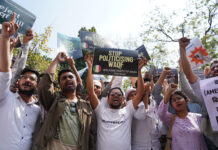Transparency International, a Berlin-based corruption watchdog, has ranked Afghanistan 150th in its annual corruption perception index for 2020 – 24 places higher than under NATO occupation in 2021.
The ranking seems to confirm widespread anecdotal evidence in Afghanistan that the Islamic Emirate has made significant anti-corruption strides compared to the NATO occupation era when corruption was sky high.
For more than a decade NATO occupied Afghanistan was continuously ranked among the 10 most corrupt governments. In 2011 the country was ranked 180th, next to North Korea and Somalia.
Since liberating the country of foreign occupiers in August 2021, the IEA has reportedly reduced bribery and extortion in public services, which has provided financial lifelines for an isolated government that faces crippling international economic and banking sanctions.
The IEA says revenues from their tax collections reached $1.7 billion in the last 10 months.
The United States spent $146 billion to rebuild Afghanistan, according to the Special Inspector General for Afghanistan Reconstruction (SIGAR).
“The United States failed to recognise the magnitude of corruption early on, empowered warlords and other corrupt actors and poured too much money into the country at a rate that it could not be absorbed,” Shelby Cusick, a SIGAR spokesperson, told VOA.
Subscribe to our newsletter and stay updated on the latest news and updates from around the Muslim world!
Last week, the World Bank delivered an upbeat assessment of the Afghan economy in the first nine months of the fiscal year 2022, citing high exports, a stable exchange rate and strong revenue collection.
The World Bank assessment noted that inflationary pressure has eased since July of last year, decelerating by half to 9.1 % in November, while most basic food and non-food items remain widely available. The report attributed the decline in inflation to lower global oil and food prices, along with a stable exchange rate.
Afghanistan exported $1.7 billion worth of goods, an increase of approximately 90% compared to the full year 2021, the bank reported. Pakistan, with 65%, and India, with 20%, remain the two main export destinations for Afghan vegetable products, mineral products, and textiles.
The January-June 2022 data shows the country imported $2.9 billion of goods. Neighbouring Pakistan, China, and Iran are identified as the main import origins.
The World Bank assessment said revenue collection had remained strong, reaching $1.54 billion between March and December 2022, in line with 2020 results.
In other findings, the World Bank report said nominal and real wages rose slightly in December. It noted that most Afghan civil servants have received salaries regularly, with women reporting they are being paid more regularly than men over the last two months.
Afghanistan’s population was estimated to pass 43 million in 2022, and a staggering 28.3 million people will need urgent humanitarian assistance this year in order to survive prolonged drought-like conditions, according to latest U.N. assessments.























